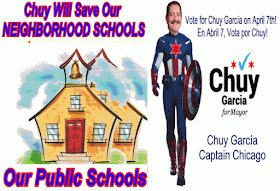School Agenda Bedevils Chicago Mayor in Race
CHICAGO — The sky-blue paint has begun to peel on the three-story building that was once Anthony Overton Elementary. Window air-conditioners are speckled with rust. Doors where children used to rush in and out are sealed with plywood.
The empty shell of this school on Chicago’s largely black South Side stands as a reminder of one of Rahm Emanuel’s defining acts as mayor: overseeing the closing of nearly 50 public schools deemed underperforming, underutilized or both. It was the largest closing of schools in memory, with many of them in black or Latino neighborhoods.
For the mayor, this was one step toward bringing better education to students trapped in failing schools amid a fiscal crisis. Overton, after all, was nothing to brag about. Its test scores put it in the lowest tier of the nation’s third-largest school district, and it had been placed on probation by school officials for three years. The population in Chicago had shrunk over time, some students had chosen alternatives like charter schools, and Overton was only half full.
But for families who saw Overton as an institution that gave the neighborhood stability, the decision was a blow. “It hurts,” said Earvin Wade, 55, who lives across the street. “You used to have a lot of kids there, families around. It was at the heart of our neighborhood. Now it’s nothing but an eyesore.”
As Mr. Emanuel faces an unexpected runoff election for mayor, questions are percolating through the race about his brusque style, his handling of gang violence and whether he has favored wealthy downtown interests over ordinary neighborhoods. But in the end, it may be the education agenda that he proudly, defiantly and swiftly carried out that threatens his political future.
Like many mayors of big cities, Mr. Emanuel, a Democrat, came into office four years ago bluntly pledging to turn around a troubled school system and improve graduation rates, which hovered around 58 percent. He was withering in his critique, asserting at one point that students were getting “the shaft.”
Mr. Emanuel sought to reduce dropout rates and extend the availability of preschool and full-day kindergarten. He pushed to toughen teacher evaluations and oversaw an expansion of charters schools, which are privately run and publicly funded. He demanded an increase in the length of the school day — which compared unfavorably with that of other major cities — helping set off the first teachers’ strike in a quarter-century.
Teachers, who said they felt attacked by Mr. Emanuel and carried pointed signs with messages like “What’s Rahm With You?” during the strike in 2012, are now leading the charge against him.
Chicago Teachers Union leaders urged Jesús G. Garcia, a county commissioner known as Chuy, to enter a wide field of candidates in the first balloting last week against Mr. Emanuel. And they said they would be pressing efforts on behalf of Mr. Garcia, who finished second to Mr. Emanuel, forcing him into the runoff election on April 7.
Teachers’ groups, including national unions like the American Federation of Teachers, have donated at least $500,000 to elect Mr. Garcia, though Mr. Emanuel has raised far more. In one sign of the environment Mr. Emanuel faces, advisory measures calling for the school board to be elected instead of appointed by the mayor won overwhelming support from Chicagoans on ballots last week.
“That’s a pretty strong message to Rahm about what people thought about his education agenda,” said Randi Weingarten, president of the American Federation of Teachers. “His education agenda is based on sanctions and punishing and tests in lieu of the professional judgment of educators.”
Despite the opposition from teachers, Mr. Emanuel boasts of his record on education, ticking off school statistics he likens to the report cards he says his parents used to post on the family refrigerator for all to see.
“We had to make changes in the structure of the system that was holding our kids and our teachers back from doing what they do best,” Mr. Emanuel said in an interview. “Now, we’re not done. It’s not over. There are things that have to get done. But they’re finally pointing in the right direction and repeatedly doing better and better each year.”
During his first term, graduation rates rose to just under 70 percent, a high for the Chicago system, according to school officials. The number of African-American students in Advanced Placement classes grew by 40 percent. Suspensions and expulsions dropped.
In the wake of the strike, school days grew to seven hours for public elementary school students, up from less than six, school officials said, and students now attend class 178 days a year, not 170. Mr. Emanuel has pressed for a new program that provides free tuition to the City Colleges — the local community college system — for public school students who graduate with a B average or better.
“This is someone with a vision,” said Juan Jose Gonzalez, the Chicago director of Stand for Children Illinois, an education group that has endorsed Mr. Emanuel.
Yet on the South and West Sides, people seem to remember Mr. Emanuel most for the decision his appointed school board made to close nearly 50 public schools from among the district’s more than 700.
Of the closings, Mr. Emanuel said the choice had been vexing but School Agenda Bedevils Chicago Mayor in Race - NYTimes.com:
Click here to go to Jesus "Chuy" Garcia for Mayor of Chicago Website




